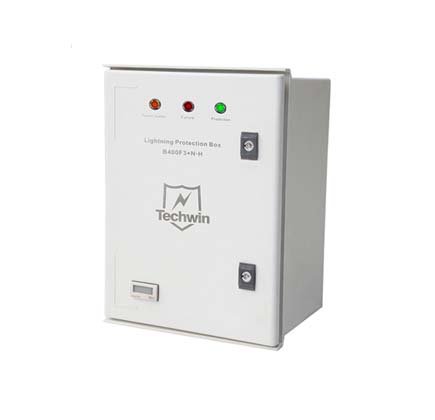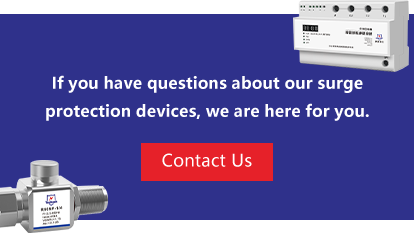As computer networks become increasingly integrated into people's lives and work, heralding the advent of the digital and information era, the importance of data center rooms and lightning protection becomes more evident. Therefore, this article focuses on the analysis of surge protection boxes.

The most common type is the power surge protection box. The power surge protection box mainly includes sealed power surge protection boxes, open-door power surge protection boxes, explosion-proof power surge protection boxes, distribution power surge protection boxes, and matrix power surge protection boxes, among others.
Based on usage environment, they can be divided into outdoor power surge protection boxes and indoor power surge protection boxes.
Based on connection method, they can be divided into series type and parallel type.
Note: Allsurge protection boxes must have reliable grounding!
Surge protection box modules use voltage switching type and voltage limiting type modules (or integrated MOV). They are typically installed in distribution rooms, distribution cabinets, AC distribution boards, switch boxes, and at the power input of other critical or vulnerable equipment to protect them from overvoltage damage due to lightning along the power lines. They are widely used in communications, electricity, transportation, finance, railways, civil aviation, and other systems for main power source protection.
Indicators for standalone power operation, lightning protection failure, degradation alarms, and indications are available. Features also include automatic lightning strike counting, remote interface, remote indication of main switch status (optional), dual power supply systems, top and bottom input/output structures (available in distribution type surge protection boxes), and using waterproof, fireproof, moisture-proof boxes.
Surge protection boxes are wall-mounted with input/output lines at the bottom. Install them with the power disconnected to avoid accidents.
Use Kevin wiring method (i.e., series wiring, with specific input/output lines, refer to Attachment 1 for detailed instructions): Pass all power input lines (A, B, C, N from the main switch lower output of the previous distribution cabinet) through the residual current transformer, then pass lines A, B, C through their respective working current transformers and connect the N line to the input terminals (each phase has 2 terminals, input on the left, output on the right) of the surge protection box. Connect the output A, B, C, N lines to the input terminals of the distribution switch in the previous distribution cabinet. Ground the protection box properly at the 'PE' terminal block inside the box.
Conventional parallel wiring: Directly connect the power input lines (from the main switch lower output of the previous distribution cabinet) to the input terminals of the surge protection box. Note that in this method, the residual voltage is high, which is not conducive to equipment protection, and working currents and residual currents cannot be gathered for data.
Surge protection boxes require no special maintenance, just periodic checks to ensure connections are tight and status indicators are normal.
 What is type 2 surge protection?February 24, 2023What is type 2 surge protection?view
What is type 2 surge protection?February 24, 2023What is type 2 surge protection?view What Are the Lightning Protection Devices?September 18, 2021The whole set of lightning protection devices can be divided into flash catcher, lead wire, lightning protection and grounding device. Lightning protection device is to prevent the equipment from bein...view
What Are the Lightning Protection Devices?September 18, 2021The whole set of lightning protection devices can be divided into flash catcher, lead wire, lightning protection and grounding device. Lightning protection device is to prevent the equipment from bein...view The Relationship Between Up and in in Surge Protector (SPD)July 8, 2022Shenzhen Techwin Lightning Technologies Co., Ltd has independently successfully developed a series of products: SPD surge protector, power surge protector, power surge protector, signal surge protecto...view
The Relationship Between Up and in in Surge Protector (SPD)July 8, 2022Shenzhen Techwin Lightning Technologies Co., Ltd has independently successfully developed a series of products: SPD surge protector, power surge protector, power surge protector, signal surge protecto...view Installation Steps of The Surge Protection DeviceAugust 30, 2021Ⅰ. Tools of installing a surge protection deviceBefore installing the surge protection device, tools such as a flat-blade screwdriver, a pair of wire strippers, some pliers and electrical tape are ne...view
Installation Steps of The Surge Protection DeviceAugust 30, 2021Ⅰ. Tools of installing a surge protection deviceBefore installing the surge protection device, tools such as a flat-blade screwdriver, a pair of wire strippers, some pliers and electrical tape are ne...view Principle and Function of Signal Surge Protective DeviceMarch 18, 2025Working Principle of Signal Surge Protective DevicesSignal surge protective devices form a protective barrier by connecting in series between the signal channels and the equipment. When a surge voltag...view
Principle and Function of Signal Surge Protective DeviceMarch 18, 2025Working Principle of Signal Surge Protective DevicesSignal surge protective devices form a protective barrier by connecting in series between the signal channels and the equipment. When a surge voltag...view Surge Protector for Closed-Circuit Television SystemJune 26, 2024This article will introduce the importance and working principle of surge protector for CCTV that meet the high availability requirements of closed-circuit television systems.The Necessity of Surge Pr...view
Surge Protector for Closed-Circuit Television SystemJune 26, 2024This article will introduce the importance and working principle of surge protector for CCTV that meet the high availability requirements of closed-circuit television systems.The Necessity of Surge Pr...view